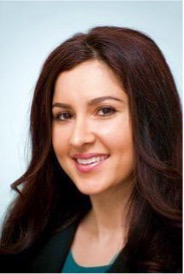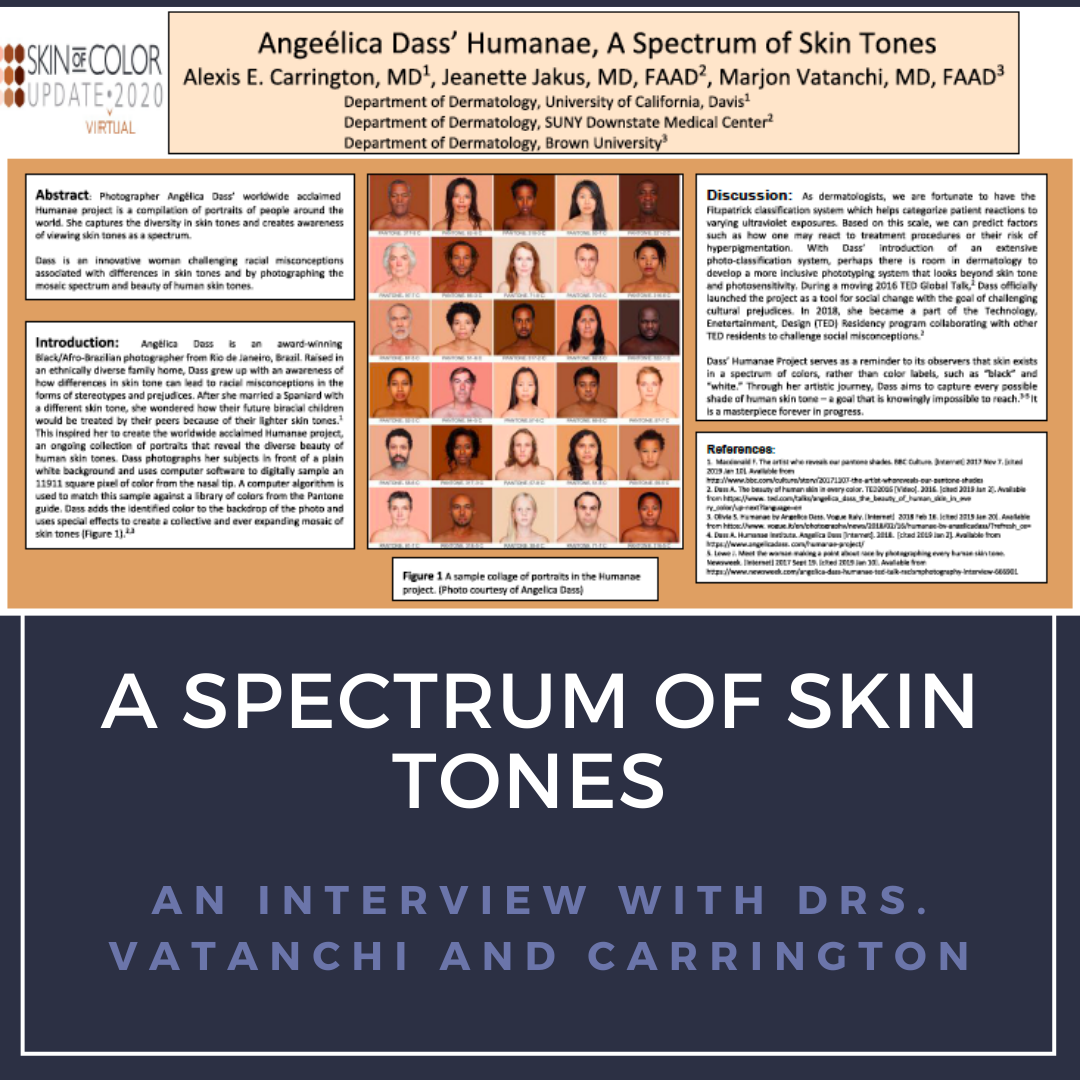Skin of color is often interpreted simply as “non white” when in fact it should be viewed as a variety of hues on a spectrum. It is important for dermatologists to be equipped with the necessary skills to treat an array of skin tones because one finite mistake can cause unfavorable results depending on the amount of pigment in a patient’s skin. I had the pleasure of interviewing Dr. Marjon Vatanchi and Dr. Alexis Carrington, authors of the poster titled “Angélica Dass’ Humanae, A Spectrum of Skin Tones” along with Dr. Jeanette Jakus, which was featured at the 2020 Skin of Color Update conference. This interview discusses the importance of this topic in dermatology in order to correct the false narrative pertaining to skin tones and bring awareness to this issue.
To view the poster, click here.
Q&A:
1. How have you seen the field of Dermatology’s phototyping system change over time?
“The current prototyping system in dermatology is the Fitzpatrick classification system which takes into account skin features along with tanning ability. As of now, a new skin-typing system has not been implemented; however there has been an increased awareness and need for inclusive skin classifications. Physician societies such as the Skin of Color Society are bringing more awareness to the necessities and variations in treating ethnic skin tones.”- Vatanchi
2. With the overall objective of creating awareness on the importance of viewing skin of color as a spectrum, how will this shift in mindset affect your patient population?
“Viewing skin tones on a spectrum rather than a finite category allows for more inclusive recognition of skin tones. Furthermore, this shift creates positive interactions with patients of all skin types. The current Fitzpatrick classification scale is a good starting point until a broader classification system is adopted. The work of Angélica Dass is a perfect example of such a system. She uses the Pantone color codes to classify skin tones of different cultures expansively, and this is a great example of showing the spectrum of skin hues and tones.”- Vatanchi
3. Have you witnessed any clinical cases where a physician’s misconception about skin tones negatively impacted the patient and caused adverse treatment outcomes?
“As a person who would qualify under Skin Type V or VI, it has crossed my mind as to why lighter skin tones have been historically labeled as “fair”, while darker skin tones are not described as such. It does make me ask why my dark skin is not viewed as appealing as a lighter skin tone. Myself and others with darker skin tones have been on the receiving end of being told “you’re too dark” from someone in the general public. I was told by a kindergarten classmatewhen I was 5 years old, “you’re as dark as a crayon”. Repeatedly experiencing things like that does have an affect on the psyche and the perception of self. – Carrington
“A lack of understanding of how African and Asian skin tones react to lasers and chemical peels has been an issue in the past; however, a lot of lectures and awareness has been dedicated to this topic in the last decade at national and international conferences in our field. Today, board-certified dermatologists are experts in the field of treating skin of color.” – Vatanchi
4. How do you suggest other dermatologists use Dass’ Humanae Project to transform their thoughts in order to change this social fallacy about skin of color?
“It begins with viewing skin through a scientific lens. Skin tones are a direct result of the variance of melanin production. As we have seen with Angelica Dass’ Humanae project, being “white” does not mean you will have lighter skin just as being “black” means you will have darker skin. We all fall within a skin tone spectrum with beautiful varying hues and colors which must be acknowledged and accepted.”- Vatanchi
“Viewing skin tones in the way Mrs. Dass has presented could help us change the social fallacy and even some misconceptions that skin and even race are made up of few primary colors and types. It helps to remind us the only reason our skin colors are a spectrum is because of a simple skin pigment called Melanin. And people of different races and ethnicities can have the same skin tones. With this in mind, we must deconstruct the narratives which allow skin color and race to divide us. In the end, our spectrum of skin tones are what unites us.”- Carrington
About the Authors:
 Marjon Vatanchi, MD
Marjon Vatanchi, MD
Dr. Marjon Vatanchi is a Board-Certified Dermatologist with expertise in cosmetic and aesthetic medicine, procedural dermatology, pediatrics, and skin of color. She has experience in treating all skin types and takes pride in teaching her patients about their skin. She completed a rigorous dermatology residency in New York City, additional fellowships in pediatric dermatology and clinical research, and began working at Brown University prior to moving out West where she practices in Newport Beach, California. She takes pride in providing her patients with excellent care and answering all of their questions in detail. In her spare time, she mentors medical students from underserved populations and those that have gone unmatched in the residency match process. She loves teaching and continues to publish and mentor residents at her practice. Currently, she serves as a committee member on multiple boards for the American Academy of Dermatology, American Society for Dermatologic Surgery, and Women’s Dermatology Society.
 Alexis E. Carrington, MD
Alexis E. Carrington, MD
Dr. Alexis Carrington will be beginning her dermatology residency at GeorgeWashington University in Washington,
D.C. in 2022. Dr. Carrington earned her B.S. in Biology and a minor in French from Pepperdine University Seaver College in Malibu, CA. She graduated with Honors from St. George’s University School of Medicine in 2019, completing her basic science curriculum in Grenada, West Indies and her clinical years in Brooklyn, New York. Dr. Carrington completed her Internal Medicine Preliminary year at Mount Sinai Icahn School of Medicine Elmhurst Hospital Program in New York City, the epicenter during the initial onset of the COVID-19 Pandemic. Currently, Dr. Carrington is a Postdoctoral Research Fellow at the University of California, Davis Department of Dermatology. There, she conducts research in the role of the gut and skin microbiome on various dermatological conditions, Mohs surgical procedures, skin of color and pediatric dermatology.
In her spare time, she loves to spend time with her family and Doberman Pinscher, travel, golf, and scuba dive.
Acknowledgements
The author would like to thank Dr. Lauren Payne, Chairperson to the Board of Directors at Comprehensive Medical Mentoring Program (CMMP) for her guidance on conducting this interview.
Did you enjoy this article? Find more on Skin of Color topics here.

